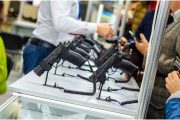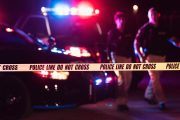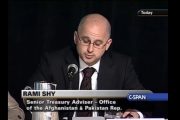
Did you know that, technically, it is illegal to cram a week’s worth of medications into one convenient bottle? And if airport screeners want to randomly check your carry-on for valid prescription labels, they may — and without probable cause, too? Remember Rush Limbaugh and baggage screeners’ inspection of his bottle of Viagra? Suddenly, actions nobody ever thought about are suspect to bureaucrats, whose primary purpose in life is to ensure increases in the size of their workforces and budgets. The Drug Enforcement Agency is just one more government entity that now has a role in Homeland Security.
Younger adults may not recall, but airport screening actually predated the 9/11 attacks. In the wake of the Libyan-sponsored incidents over Lockerbie, Scotland, the bombing of a French DC-10 over Niger, and the Rome and Vienna airport attacks, among others, in the 1970s and ’80s, screening of air passengers began in earnest — to little avail as it turned out.
Prior to the 1970s, American airports had minimal security arrangements to prevent these apparently random aircraft hijackings. Sky marshals were introduced in 1970, but there were insufficient numbers to protect every flight and did little good. In late 1972, the Federal Aviation Administration required that all airlines begin screening passengers and their carry-on baggage by January 5, 1973. This screening was generally contracted to private security companies. Airlines had operational control of the departure concourse even though oversight technically came under the FAA. By the late 1980s, though, individuals attempting to, say, carry tuxedos and formal gowns onboard to place on hangers, as was previously allowed, found themselves thwarted. They were forced, usually rudely, to cram delicate and expensive clothing through Plexiglas holes, or have them groped and even damaged by low-paid contract screeners, who were irritated at what they deemed frivolous activity.
That would prove to be only the beginning. Thanks to Richard Reid, the “shoe-bomber,” everyone was soon taking off their shoes, coats, heavy sweaters, hats, and so on. People started wearing their “grubbies” so as to forego the ordeals of metal zippers and buttons that set off the alarms. Eventually, alarm systems were improved so as not to be so sensitive, but never again would one just enter an airplane in a dignified manner and sit down.
Passengers had to run a gauntlet of inconveniences, such as limiting the number and types of items they could carry onboard an aircraft. Those who failed to present a government-issued photo ID had to submit to increased screening. Though this may have helped discourage the garden-variety, unsophisticated hijacker, it did little to hamper the larger threat of terrorism. Yet within a couple of years, everything from face cream and Talcum powder to disposable razors to pill-splitters was suspect. Finally, even plastic utensils and glassware for a quick, pre-board meal were gone from airport food courts. While plastic forks and spoons have started making their appearance again, the old rituals of meeting one’s party at the gate and taking a homemade bread to Grandma’s for the holidays were finished.
What Next?
Next up on Homeland’s Security’s to-do list: screening of air freight. Never mind that miles of high-tech conveyor-belts already check luggage at most major airports for explosives, costing taxpayers and passengers some $3.6 million per airport. Some of these systems capture an image of each bag and track it with a bar code, flagging bags containing suspicious items, so they can be checked by hand. At other airports the bag-check effort amounts to random spot-checks, with little actual physical searching. Some five to seven percent of bags actually get flagged and sent to a separate room for Transportation Security Administration (TSA) workers to search — and airport security is only as good as its weakest link. The “flags” mostly consist of items such as unlabeled travel-size perfume bottles and cosmetics, odd-shaped travel-mirror stands, and other items mostly carried by women. This increases the annoyance factor. Repackaging cosmetics to accommodate TSA screeners takes women, in particular, hours of time, whereas a man might throw a can of shaving cream, a razor, and mouthwash into his checked baggage and call it a day. Women wind up purchasing things like hair spray at their destination and throwing away whatever is left over.
Since no one can now lock luggage, there is nothing to do to protect the contents of one’s luggage, unless one wishes to insure or mail expensive products. When something is stolen or damaged, it’s your word against the TSA, and few complaints against that body — ranging from rudeness to damage — are pursued. Searched bags typically contain a note indicating they have been inspected, and unfortunately, many items often wind up stolen or missing. (For example, on March 31, 2006, at Honolulu International Airport two baggage screeners stole thousands of dollars in yen from outbound Japanese tourist luggage. According to prosecutors, the baggage screeners were part of a group that stole money from outgoing luggage, then divided the loot.
Now such freight is also in the pipeline for inspection; anything you mail — from cookies to Grandma to an expensive lamp bearing a furniture store label, means delay, damage, and rot because the TSA doesn’t have anywhere near the staff required to pull off freight screening. Thus, according to a report in the Orlando Sentinel, the government expects a horrendous backlog — boxes and crates galore sitting for days, weeks, or even months in holding areas — and lots of angry people. Increasing staff, technology, and training to accommodate the effort will no doubt be portrayed as a responsible attempt by government to mollify public angst. But the vast increase in unnecessary searches and expensive outlays will pacify few. The entire endeavor will add to an outrageous national debt and probably not stop terrorists anyway.
And that’s not all. A December 8 Associated Press story reported that the Obama administration is pushing an effort to have the federal government oversee so-called safety of subways, light rail, and other urban train systems.
Let’s be clear: Trains have become a backup mode of travel for passengers, and urban transit systems are a necessity for the employed. Transit systems carry some 14 million passengers daily. That’s more than airlines or long-distance passenger railroad. If every subway and train starts being subjected to the same inconveniences as airlines, people will simply drive, which means more cars on already gridlocked highways. Even so, Transportation Secretary Ray LaHood, in testimony before a House panel, outlined his plan to give the Federal Transit Administration authority to set standards and inspect the nation’s 50 local rail transit systems in 27 states.
So far, there are no nationwide minimum standards for rail transit safety (the term “safety” now expanded to include both mechanical problems and terrorist activity), only voluntary ones. The administration’s proposal “would effectively eliminate a legal prohibition in place since 1965 that prevents the federal government from imposing broad transit safety standards.” Sensible lawmakers admit that rail-transit systems have a significantly lower accident rate than freight or long-distance passenger trains, which are subject to federal safety regulation, and according to the Associated Press, these lawmakers are reluctant to impose new regulations on systems that for the most part are already quite safe, at least from a mechanical standpoint. But, of course, that kind of safety is not the point. Inasmuch as “safety” has assumed a double meaning in this context, this means inspections of individuals and their goods, not merely mechanical issues.
What raises the hackles of passengers, though, is that even as the federal government looks to screen rail passengers and their packages, recent incidents highlight the lack of seriousness with which the United States has addressed violent crime, particularly in the context of crime against passengers — i.e., muggings, purse-snatchings, and so on. Government has been lax in this area, even in high-profile cases, for years. Take the case of Bernhard Goetz, then a 39-year-old electronics specialist. On December 22, 1984, Goetz, who had already been mugged twice before, was harassed yet again by a small band of thugs, whereupon he aimed a gun and shot and paralyzed one of his tormenters. He was acquitted of attempted murder and assault, but was convicted of criminal possession of an unlicensed weapon and spent 250 days in jail. Four years later, his attorney, Barry Slotnick, was mugged and robbed getting into his car. He suffered a broken wrist and head injury. Now, government is misdirecting its efforts in the fight against terrorism just as they misdirected efforts to stop run-of-the mill violent crime.
Eight years after the horrific attacks of September 11, 2001, the United States, out of misplaced concern for “diversity,” has failed to construct a viable deterrent to crossings at the U.S. borders to stem the flow of illegal and easy immigration, or to detain suspicious individuals, or to keep violent offenders in prison despite so-called Truth-in-Sentencing laws. Notice, however, how quickly government can erect “traffic” cameras at nearly every intersection as soon as it becomes evident that it can make money by ridiculously expanding the criteria by which individuals can be “caught” — with little or no increase in public safety and no additional crime-fighting efforts.
Just Smile
The extent of the examination of train passengers seems to have no bounds — if new technologies used in airports are any indication. Newer technologies (mostly limited so far to isolated projects) include General Electric’s Secure Registered Traveler (SRT) system, which incorporates automated carry-on scanning, automatic biological pathogen detection, millimeter-wave full body scanning, and a quadruple resonance carpet that would detect threats in shoes without having to take them off. The SRT program also works with SmartCard technology and with fingerprint data to help verify passengers. The fingerprint scanner also detects for explosive material traces on the person’s fingers. These technologies are aimed at providing a more detailed search that is less intrusive to passengers and deemed less harmful than X-rays. The costs, however, are passed along to taxpayers, as will be the hassles: Imagine the questions you’ll have to answer to get on a train if you’re a person who goes to a target range to shoot guns and get gunpowder residue on your clothes.
With the increase in security screening, airports endure long queues for security checks. To alleviate this, some airports have created Premium lines for passengers traveling in First or Business Class, or programs like Clear®, for those willing to shell out big bucks for the dubious privilege of pre-inspection via an extensive background check. Wikipedia reports “a few dozen airports [worldwide] that have instituted a ‘trusted traveler program’,” a security measure that attempts to detect people who are real threats, and searching them. They argue that “searching trusted, verified individuals should not take the amount of time it does.” All true, of course. But U.S. bureaucrats know that screening (and inconveniencing) everyone ensures political correctness, while simultaneously reminding us, in effect, who’s boss.
The “screening passengers by observation techniques” (SPOT) program is also operating at some U.S. airports. It entails yet another scheme, this one to place “behavioral detection officers” (BDOs), who are basically psychologists, at airports. But instead of combing manifests for dangerous characters, these officers are charged, apparently, with the task of looking for irritated passengers and pulling them out of line — a tactic reminiscent of doubling the fine for anyone who argues with the law enforcement officer pulling over a driver for some perceived infraction.
Moreover, the number of security breaches (much less, attacks foiled) compared to the senseless intimidation of law-abiding passengers has not lived up to its billing, any more than have “traffic” cameras saved lives. Freight screening and public transit/rail screening will fare no better, given (a) the expense, (b) the lack of manpower, and (c) the lack of attention to more urgent anti-terror efforts, such as illegal immigration and border control, since 9/11.
The purpose of this latest foray into “screening” appears mainly to be aimed at acclimating the populace to tolerate a ubiquitous government presence, forever on the lookout for “gotcha” infractions. Throwing the weight of government around has always been a precursor to a police state — a work in progress, right here at home.
Beverly K. Eakman is a former educator and retired federal employee who served as speechwriter for the heads of three government agencies as well as editor-in-chief of NASA’s newspaper (Johnson Space Center). Today, she is a Washington, D.C.-based freelance writer, the author of five books, and a frequent keynote speaker on the lecture circuit. Her most recent book is Walking Targets: How Our Psychologized Classrooms Are Producing a Nation of Sitting Ducks (Midnight Whistler Publishers).



